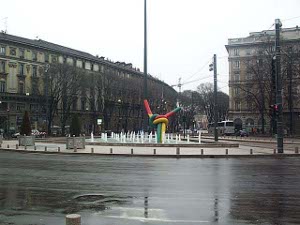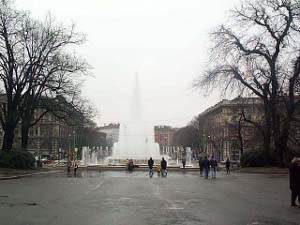 Piazza Cadorno
Piazza Cadorno
Today dawned grey with occasional light rain, just like the last three days. We started out by taking the Metro two stops to Piazza Cadorno, which has a fountain and a modern sculpture of wormlike shapes in primary colors.
From there we walked a few blocks to Castello Sforzesco. This giant brick structure, the seat of the Dukes of Sforza, is blocks long and blocks wide; there's another, more elaborate fountain in the piazza in front of the castle.
 Piazza Cadorno
Piazza Cadorno
We knew our luck had changed for the better the moment we entered the castle museum. A warm and gracious young lady determined that we were anglophones and gave us an overview of the entire museum, carefully, and in good English. She was quite concerned that we understood her and would enjoy our visit. We assured her we would, and we did.
The museum staff, with the help of the Rotary Club, is in the process of making the museum bilingual -- Italian and English. Perhaps the most impressive gallery is the sculpture gallery, on the ground floor. In each room there is a wooden stand on the floor holding two stacks of paper, one in each language. The sheets of paper, printed on both sides, with illustrations, provide an excellent summary of the works represented by that gallery. There were almost twenty galleries, so we accumulated a thick pile of paper, the equivalent of a complete guidebook to the sculpture museum.
Beginning with sculpture fragments from the fourth century, the walk through the rooms took us through the next twelve hundred years. The examples are dramatic and beautiful, with intricate carvings and traces of color showing what they must have looked like when they were new.
The walls and ceilings of the castle had all been painted or frescoed; one of the rooms had been decorated by Leonardo. The decorations were covered with a whitewash, and rediscovered in the nineteenth century when the entire castle was restored.
Perhaps the most famous sculpture in this museum is a Pieta by Michelangelo; all the sheets of paper (in both Italian and English) had been taken. But the white life size marble spoke for itself.
Of course a visit to a museum wouldn't be complete without some military interest, so when we saw a suit of armor mounted on a model of a horse we took a picture. We call it, "Reservist On His Way to Drill."
The first floor had furniture and paintings, as well as some more decorated rooms; we were delighted to find another Arcimbaldo ("Spring") to go along with those we had seen in the Historische Kunstmuseum in Vienna.
We passed up the archaeological galleries and instead found our way to the museum of old musical instruments and instrument making. This was fascinating; we had never seen such a variety of old instruments in one place  Castle Sforzesco courtyard
before. There was a great collection of lutes, guitars, and bowed instruments, some of which had such an odd arrangement of strings they were funny. It was clearly more interesting to look at these instruments than it was easy to make them produce beautiful music!
Castle Sforzesco courtyard
before. There was a great collection of lutes, guitars, and bowed instruments, some of which had such an odd arrangement of strings they were funny. It was clearly more interesting to look at these instruments than it was easy to make them produce beautiful music!
There were also several rooms displaying the manufacture of instruments, especially violins; not surprising since the Italians are the master violin makers.
We left the Castello Sforzesco in fine spirits and thought we'd wander through the park, marked on our map with a splotch of green, just behind it. This turned out to be rather interesting, as evidently the park is where the Milanese come to do their drug deals; we saw three cop cars and two busts in progress as we walked through the park. We were happy it was the middle of the day, because this neighborhood is not at all nice. It's strange how the bad neighborhoods of cities are just a few blocks from the good neighborhoods. So far we have seen Polizei in their blue uniforms with white helmets and blue and white cars; Carabinieri in black uniforms with large guns, and Vigilenzi in a kind of green nylon uniform standing in front of our supermarket.
At the end of the park is the giant Arco Della Pace, which is undergoing restoration. Milan is filled with these heroic gates and columns and statues, some allegorical like this gate, but many paying homage to a famous person. In Piazza Da Vinci the statue was in more modern dress than the great Leonardo; it turned out to be Verdi.
We took a long meandering walk through some different parts of the city on the way back to the hotel. We had another military experience when we viewed the 1948 monument to the Italian Alpine Troops. The soldier's gun is down on the ground and he has picked up a huge rock, presumably to throw down the mountain at a foe. We would label this sculpture, "Reservist who does not have Ammunition."
Our map showed a huge region, about a dozen city blocks, labeled simply Fiera Milano, which we took to mean Milan Fair. This was approximately correct, we believe. We didn't walk all the way around, but the part we did see consisted of a number of large buildings, interspersed with gated automobile entrances. A big sign proclaimed, in English, an "international fashion and accessories show for large volume distribution."
We've been reading a short history of Italy, and in many senses, it is the most fragile of all the western European democracies we have visited. Perhaps the biggest problem is the tremendous imbalance between the North and  Fountain at Piazza Sforzesco
the South. The North has all the industry and the wealth; the South is on welfare. In 1987, 45% of men in the South between the ages of 14 and 29 were unemployed and looking for work.
Fountain at Piazza Sforzesco
the South. The North has all the industry and the wealth; the South is on welfare. In 1987, 45% of men in the South between the ages of 14 and 29 were unemployed and looking for work.
The various governments have not dealt effectively with this problem. For example, they have located large factories in the South, but these plants have been highly automated and provide very few local jobs. Meanwhile, the Northerners resent subsidizing the Southerners with their taxes, so new regional political parties have been formed.
These political difficulties can be traced back in time; Italy was a collection of separate feudal states, speaking widely different dialects, when it was "unified" by Garibaldi in 1865. The regional problems have persisted since that time, with a succession of governments unable to solve them. In fact, Italy has only been a western democracy, in the normal sense, for the last 50 years.
So Italy can be viewed through two widely differing points of view. On the one hand, think of the Ferraris and Armanis and you think of fabulously successful businesses with world-class quality. On the other hand, think of Calabria and you think of a desperately poor land in the hands of vicious feudal Mafiosi. The future of Italy should be good, but there is a lot of work for the government to accomplish to create a national identity which can pull all the Italians together.